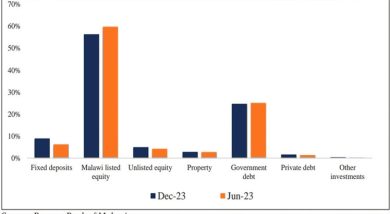Mixed fortunes for microfinance institutions
Despite registering satisfactory performance in 2018, the microfinance institutions have, during the year under review, posted mixed results in their assets and earnings.
Recently published Reserve Bank of Malawi (RBM) figures show that during the review period, aggregate assets for the sector comprising microcredit agencies, non-deposit taking microfinance institutions and deposit taking microfinance institutions, increased to K38.1 billion in 2018 from K37.5 billion in 2017.

A breakdown of their performance, however, indicates that the deposit taking microfinance subsector was stable during the review period as both earnings and asset quality improved while the performance of the non-deposit taking microfinance sector was poor as reflected by decrease in total assets and poor asset quality.
With regard to financial cooperatives, the sector continued to register growth in all financial aspects mainly due to enhanced supervision oversight.
According to RBM figures, total assets of deposit taking microfinance institutions decreased by 15.5 percent to K12.4 billion in 2018 on account of a decrease in balances with other financial institutions and securities and investments despite registering increased income of K6.3 billion from K6.2 billion in 2017.
Although total assets of the non-deposit taking microfinance institutions decreased by 2.2 percent to K22.3 billion in 2018 due to a decrease in cash and cash equivalents to K1.1 billion in 2018 from K1.8 billion in 2017, income for the sector increased by 65.0 percent to K6.6 billion in 2018, principally on account of a decrease in short term borrowings by the lending institutions.
Total assets for the microfinance sector, on the otherhand, grew by 35.6 percent to K19.1 billion in 2018, with the total income increasing by 21.1 percent to K4.8 billion.
Malawi Microfinance Network (Mamn), earlier blamed the cost of regulatory compliance for affecting the sector’s growth and the financial inclusion agenda.
In November last year, Mamn chairperson Courie Mulder said the regulatory environment has reached a stage where the balance between ensuring best practices and cost of business is a negative variance, observing that some regulatory practices seem to infringe on a free and fair economy.
Mulder said the microfinance sector in Malawi is in its nascent stage (compared with other jurisdictions), but with huge growth potential.
RBM Governor Dalisto Kabambe said a sound, stable and developed financial system is key for the transmission and effectiveness of monetary policy and also for the development of an economy adding that 2018 was favorable to the financial sector as it operated in a stable and resilient domestic macroeconomic environment.
Malawi has 49 registered and licensed microfinance institutions comprising 40 microcredit agencies, eight non-deposit taking institutions and one deposit taking institution.





